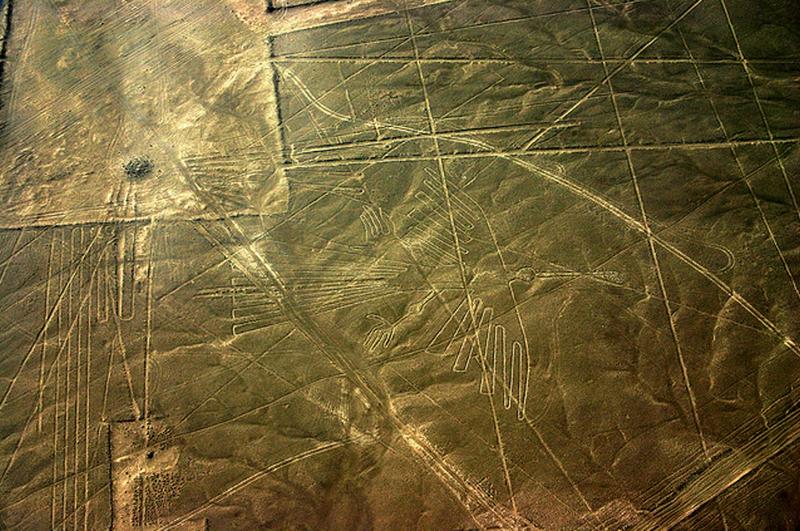The Nazca Lines of Southern Peru
By | June 23, 2019

In the deserts of southern Peru, about 250 miles south of Lima, white lines interrupt the endless sand. From the ground level, they appear as random grooves dug into the otherwise rust-colored landscape to reveal the lighter-colored sand below. But viewing them from above, as one would from an airplane, reveals many of them to be shapes, including plants and animals, etched into the desert. These are the Nazca Lines, giant geoglyphs, which have mystified researchers for more than eighty years.
The lines can be divided into three categories: straight lines, geometric shapes, and pictorial representations. There are more than 800 straight lines, some of them as long as thirty miles. There are more than 300 geometric shapes including rectangles, triangles, and trapezoids as well as arrows, spirals, zigzags, and wavy lines. The smallest, and yet most well-known, category of Nazca Lines are the pictorial representations, also known as biomorphs. There are seventy of them, ranging from fifty to 1200 feet in length. They include representations of a spider, a hummingbird, a cactus, a monkey, a whale, a flower, a tree, and a dog, among others.

The first person to study the lines was Peruvian archaeologist Toribio Mejia Zesspe in 1926. However, they were not brought to the attention of the public until the 1930s when commercial planes began flying over Peru. Naturally, giant “drawings’ created long before the invention of the airplane that could only be identified from high above sparked theories of aliens. This is likely the reason that early researchers - including American professor Paul Kosok who studied the lines in the late 1930s and early 1940s and German archaeologist Maria Reiche, who studied them for 40 years and gained the nickname, the Lady of the Lines - concluded that the lines served an astronomy-related purpose.

Later researchers of the 1960s and 1970s, including American astronomer Gerald Hawkins, disagreed with the astronomical explanations. Johan Reinhard, a National Geographic Explorer-in-Residence, suggested the lines were a part of rituals performed to obtain water. Living in the dry Peruvian desert, locating water sources would have been a major concern to the Nazca. Researchers point to animal symbolism which connects many of the biomorphs, including the spider and the monkey, with rain and water. The hummingbird, on the other hand, was associated with fertility.

While researchers disagree on why the lines were created, they’ve reached a consensus on how and when, as well as who created them. Anthropologists have concluded that it was the Nazca culture (hence the name “Nazca Lines”) which flourished from A.D. 1 to 700. However, some of the lines may have been created by the earlier cultures of the Chavin and Paracas. The lines were created by removing twelve to fifteen inches of rock, which had taken on a rust color due to oxidation, to reveal the lighter-colored sand below. Researchers believe they started with small scale models and increased the proportions to create giant designs. Because there is very little wind or rain in the Peruvian desert, the geoglyphs have remained mostly intact.

While the weather in Peru has rarely been a threat to the Nazca Lines, they are not totally safe. In 2009, heavy downpours caused rainwater to flow from the Pan-American Highway, leaving sand and clay in the fingers of a hand-shaped geoglyph. In 2014, Greenpeace activists promoting renewable energy trampled the upper layer of rocks by the hummingbird. And in 2018, a commercial truck driver drove onto part of the Nazca Lines, damaging an area of about 100 feet by 330 feet. This prompted calls for greater security and surveillance at the Nazca Lines.

